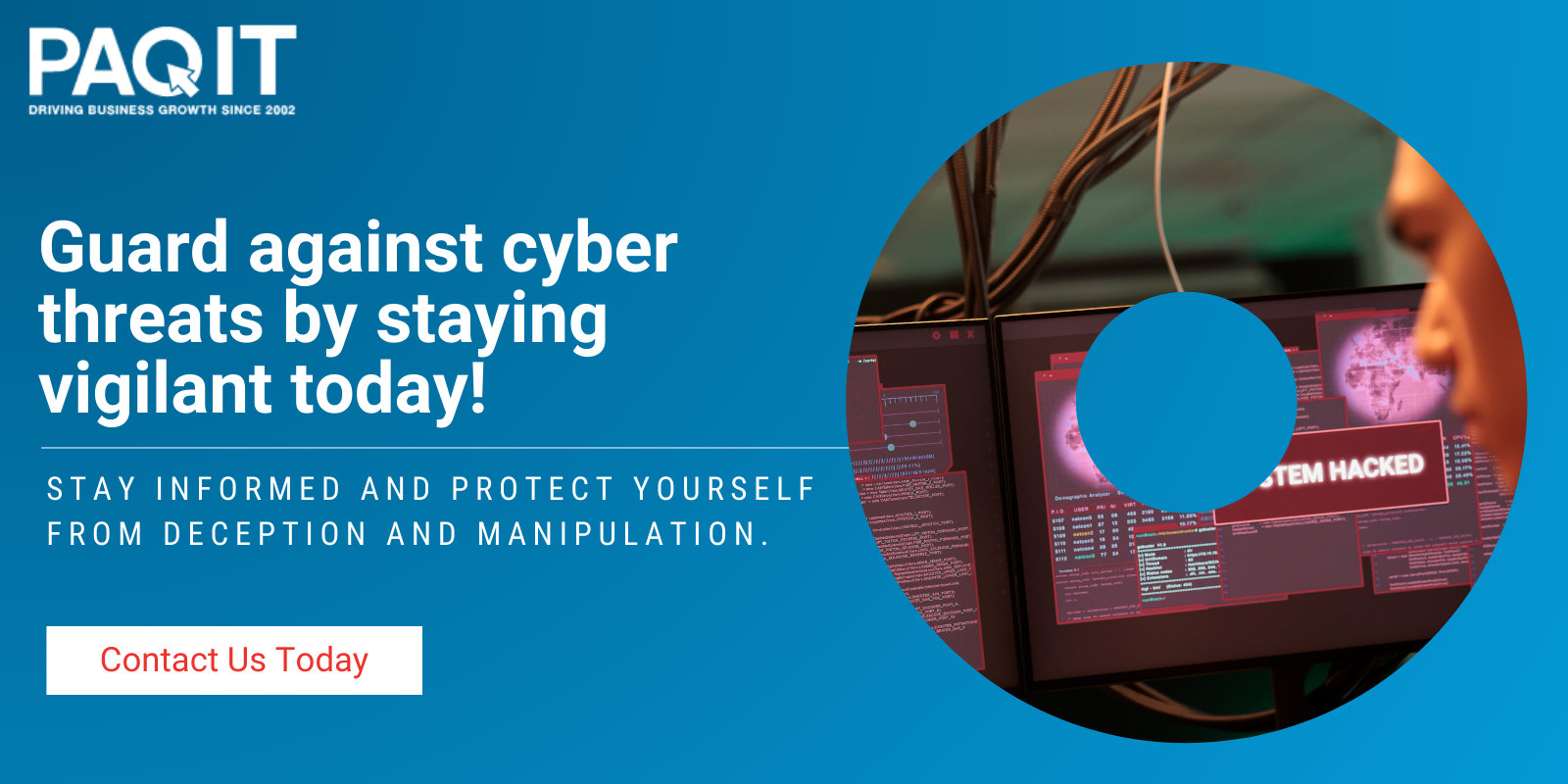When we think of cybercriminals, we often picture skilled criminal masterminds, who perpetrate sophisticated attacks against large corporations or governments. While that kind of threat actor does exist, the truth is, most cybercriminals are relatively low-tech and opportunistic in their tactics. They instead exploit weaknesses in human psychology, convincing end users to reveal sensitive information, download harmful programs onto their computers, or make fraudulent payments, using acts of deception and manipulation. These attacks are collectively known as social engineering attacks, and they are widely recognised as the leading cause of cybercrime globally.
Here at PAQ IT, our cyber security services provide a powerful defensive toolkit against the pernicious and varied cyber threats that target SMEs. We help businesses across Limerick, Cork, Galway and beyond protect their data assets, stay compliant, and operate securely using an expertly tailored blend of technical protection and security best practices.
If there’s one aspect of cyber security that many businesses neglect, it’s the human element. In fact, a 2020 study by Stanford University discovered that almost 9 in 10 data breaches are linked to end-user mistakes, making employee error the greatest digital security risk your organisation faces by a considerable margin. To help, we want to guide you through some of the most pervasive cyber threats faced by businesses today and provide practical guidance on how you can effectively fend them off. Let’s start with a threat type so common you’re almost certain to have encountered it both at home and at work: the social engineering attack.
Types of Social Engineering Attack
The exploitation of human trust is a feature common to all social engineering attacks, but it’s important to recognise the range of methods and mediums the attackers use to carry out these harmful schemes. Here are some common formats of social engineering attacks to be aware of:
Email-Based Phishing
Email-based phishing involves the use of spam emails, which are often sent in bulk to a vast pool of targets. These emails will often impersonate a trusted organisation or individual, in order to convince the target to comply with a set of instructions or disclose sensitive information. Links to credential-harvesting websites and malware-laden attachments are common, often accompanied by a compelling message that urges the user to take action with urgency to avert some sort of disaster scenario, or to avoid missing out on a “one-time offer.” Some subcategories of email-based phishing to be mindful of include:
Business Email Compromise (BEC)
BEC attacks are a targeted and sophisticated form of social engineering, whereby a scammer will intercept communications within a corporate email service and attempt to impersonate either someone senior within the company’s command chain, or a trusted external party. BEC scams often involve background research into the target company, giving them greater potency and a higher success rate than other forms of phishing. Most often, BEC attacks will attempt to elicit a direct payment or coax sensitive information from the victim.
Malware-based Phishing
Attackers often use email-based phishing as a delivery mechanism for various types of malware, including keyloggers, spyware and ransomware. Often the attacker will assume the identity of a reputable source, such as a colleague, service provider, business associate or financial institution. The emails will either encourage the target to click on a link to a malware-infested website or download and execute a malware-laden attachment contained within the email, which might be presented as an important document or invoice.
Once the malicious code is triggered, it could perform a range of harmful actions, such as recording keystroke entries to steal user account credentials, exfiltrating sensitive data, encrypting files for ransom or configuring ‘backdoor’ access for use in a future cyberattack.
Clone Phishing
Clone phishing begins with the attacker either hacking a corporate email account or intercepting legitimate business communication. This gives them access to authentic email messages within a company, which they are then able to copy for their nefarious aims, including the content, format, sender’s name and company logo. Armed with an email that appears credible, the attacker will then introduce malicious modifications such as a malicious link or attachment, before distributing the email to its intended targets.
Clone phishing can be particularly hard to combat, as the genuine appearance of the emails make them appear more credible and trustworthy. They also stand a greater chance of circumventing email security measures, due to the content closely resembling the genuine article.
Spear Phishing
Spear phishing encompasses any form of phishing attack that targets either a specific individual, group, or organisation, with the message tailored accordingly to aid credibility and chance of success. Spear phishing attacks often leverage publicly available information relating to the target organisation or individual, often gleaned from social media pages, company websites and public records.
Messages will often refer to upcoming events, company news, departmental projects, or any other contextual reference that makes the content more convincing and persuasive. Further credibility is obtained through email header spoofing, which falsifies the email’s sender field to make it appear to come from a trusted source.
However, not all Social Engineering Attacks Rely on Email…
While email-based phishing is extremely common, email isn’t the only attack medium employed by unscrupulous scammers. Here are some others to be alert to:
Smishing
Smishing (a portmanteau of SMS and phishing) refers to text message-based phishing attacks. These often bear the hallmarks of email phishing campaigns, with messages that convey a sense of urgency, and links to malware infested sites, or bogus login pages set up to steal account credentials.
Vishing
Vishing (‘voice phishing’) is a form of social engineering that happens over the phone. The attackers often imitate recognised, trusted entities such as government institutions, financial service providers or IT support providers, in order to persuade the target to disclose compromising information or perform actions that jeopardise security. Caller ID spoofing, an affected tone of voice, and a sense of urgency are often employed to bolster credibility and compel the victim to take hurried action with little regard for the security implications.
Angler Phishing
In angler phishing, an attacker will attempt to assume the identity of a trusted corporate entity, institution or legitimate user on a social media site, forum or other online space. The attacker will try to cultivate trust among the community by sharing relevant content and participating in conversations, before introducing ‘phishing lures’ into the discussion in the form of harmful links and malicious attachments.
3 Ways to Protect Your Business Against Social Engineering Attacks:
Mitigating the social engineering threat involves using effective technical measures, alongside staff training that stresses the importance of secure communication practices. Fortify your business with multi-layered countermeasures to keep your data and digital systems out of the phishing scammer’s reach:
Train Your Team
Employee threat awareness is critical when it comes to effectively combatting social engineering attacks. Equip your team with the skills and knowledge necessary to spot and inhibit social engineering attacks, by promoting the following best practices:
- Encourage healthy scepticism. Encourage employees to exercise caution and perform ID verification when they receive peculiar requests or unsolicited communications.
- Check URLs and Email Headers. Emphasize the importance of inspecting URLs to determine the legitimacy of websites, and train staff to perform email header inspections to ensure an email originates from its claimed source.
- Discourage ‘Oversharing’ on Social Media. Attackers often use public-facing information available on social media sites to craft convincing online personas. Stress the importance of keeping business-related discussions off social media and encourage users to set their accounts to private.
- Practice Good Password Hygiene. Promote the use of long, complex passwords that are easy to remember but hard to guess, in order to minimise account takeover risks. Implement multi-factor authentication for added protection.
- Foster Awareness of the Techniques Used. Educate staff on the techniques used by phishing scammers, including the tone, messaging, and other characteristics common to their correspondence. Urge staff to be wary of messages that convey a sense of urgency or alarm, and encourage hyper-vigilance around any requests for payment or sensitive information.
Consider working with an IT support provider who can provide security awareness training to your team. They’ll be able to support you with valuable online resources designed to educate your employees, and test their readiness using phishing simulation exercises.
Implement Email Security Measures
Introduce effective, overlapping security controls to defend your digital systems against email-borne threats, including phishing, malware attachments and malicious links. Consider the following:
- Email Filtering Technologies. Use email filtering and anti-spam solutions to identify and intercept unwanted, suspicious and potentially malicious inbound mail. These systems leverage algorithms that are able to analyse email content, sender reputation, and detect the signatures of known malware threats.
- Email Encryption. Make use of email encryption to prevent hostile threat actors from eavesdropping on your sensitive email correspondence. Encryption makes information indecipherable to third-party onlookers, ensuring only authorised recipients can access confidential, sensitive information.
- Endpoint Security. Safeguard your endpoint devices against malware payloads hidden in email attachments by implementing comprehensive anti-malware countermeasures across your digital estate. Consider deploying an endpoint detection and response (EDR) solution for the added benefit of live threat monitoring and response, and ensure security updates are being applied across your network to ensure discovered security vulnerabilities are swiftly rectified.
Implement Identity and Access Management Best Practices
Attackers often use compromised user accounts as a platform for launching potent, targeted phishing attacks. Adhere to identity and access management best practices to mitigate account takeover risks:
- Apply Role-Based Access Controls (RBAC). Grant user privileges and access rights on the basis of job role, ensuring that employees have the resources they need to complete tasks while restricting access to files, systems and capabilities they don’t strictly require. This practice helps to limit the spread of harm should an account fall into the hands of a bad actor.
- Perform Regular Access Reviews. Assess permissions and access rights on an ongoing basis to ensure employees benefit from a level of access that’s aligned with their job roles and responsibilities. Ensure access rights are swiftly adjusted or removed to account for role changes, or in response to an employee leaving your company.
- Use Multi-factor Authentication. Multi-factor authentication provides an added layer of account protection by requiring an additional form of user ID that’s extremely difficult to hack or spoof. Use biometrics, one-time passcodes, and token-based authentication to reinforce the security of your user accounts.
Final Thoughts
Social engineering attacks are a ubiquitous danger in today’s digitised business environment. Engender a culture of cyber security awareness, equip your employees with insights into the dangers, and configure effective technical measures to keep your data and systems secure against opportunistic phishing fraudsters.
PAQ IT – Your Premier Choice for Managed IT Services, Support, and Solutions in Limerick, Cork, Galway, and Beyond!
At PAQ IT, we’re dedicated to assisting businesses throughout Limerick, Cork, Galway, and beyond in embracing digital transformation for sustained growth and success. Through our innovative “Kaizen 360” program, we enable businesses to harmonize their people, processes, and business technology, unlocking the 75% of value often overlooked by other IT support providers.
From comprehensive cyber security services to cutting-edge cloud solutions, efficient process automation to top-notch IT support, PAQ IT offers tailored, end-to-end packages to meet all your IT requirements seamlessly, allowing you to focus on managing your business effectively. Let PAQ IT be your trusted partner in navigating the dynamic technology landscape, ensuring your prosperity in Limerick, Cork, and Galway.
Ready to elevate your business in Galway, Cork, Limerick, or beyond with the transformative power of our Kaizen 360 program? Take the first step towards seamless digital evolution. Contact us today for a complimentary consultation and discover how PAQ IT can empower your business’s growth and success in Galway, Cork, Limerick, and beyond!


